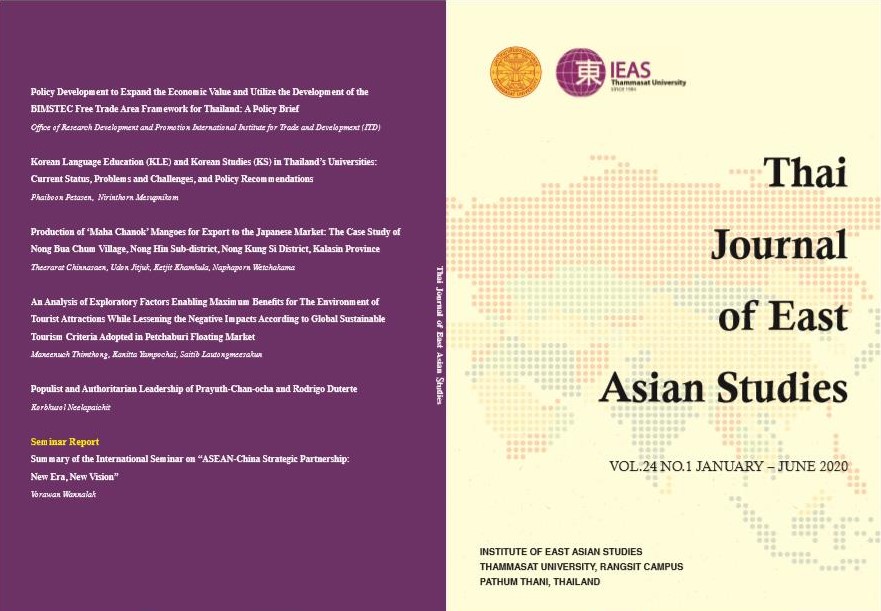การผลิตมะม่วงมหาชนกเพื่อการส่งออกตลาดญี่ปุ่น: กรณีศึกษาบ้านหนองบัวชุม ตำบลหนองหิน อำเภอหนองกุงศรี จังหวัดกาฬสินธุ์
คำสำคัญ:
มะม่วงมหาชนก, การเพาะปลูก, ผลผลิต, เกษตรดีที่เหมาะสม, พ่อค้าคนกลางบทคัดย่อ
ถึงแม้ว่าเกษตรกรในเขตพื้นที่บ้านหนองบัวชุม ตำบลหนองหิน อำเภอหนองกุงศรี จังหวัดกาฬสินธุ์ จะปลูกมะม่วงมหาชนกมายาวนานกว่า 24 ปี แต่เกษตรกรยังประสบปัญหาความผันผวนทางการตลาด โดยราคาจำหน่ายผลผลิตมีความแปรปรวนสูงหรือราคาตกต่ำในช่วงกลางฤดูที่มีผลผลิตจำนวนมาก การผลิต เพื่อมุ่งจำหน่ายยังตลาดต่างประเทศโดยเฉพาะตลาดญี่ปุ่นที่รับซื้อผลผลิตในราคาสูงเมื่อเทียบกับตลาดต่างประเทศอื่นๆ จึงอาจมีส่วนช่วยบรรเทาปัญหาดังกล่าว งานวิจัยนี้จึงมีวัตถุประสงค์เพื่อศึกษาแนวทางการผลิตมะม่วง มหาชนกและปัจจัยประกอบเพื่อการส่งออกตลาดญี่ปุ่นของเกษตรกรในเขตพื้นที่บ้านหนองบัวชุม ตำบลหนองหิน อำเภอหนองกุงศรี จังหวัดกาฬสินธ์ุ จากการศึกษาพบว่า เกษตรกรต้องได้รับการรับรองมาตรฐานเกษตรดีที่เหมาะสม (Good Agricultural Practices; GAP) สำหรับพืชก่อนจึงจะสามารถจำหน่ายผลผลิตเพื่อการส่งออกตลาดญี่ปุ่นได้ จากนั้นตัวแทนบริษัทผู้ส่งออกมะม่วงหรือพ่อค้าคนกลางจะเป็นผู้คัดเลือกผลผลิตโดยพิจารณาจากน้ำหนัก ระหว่าง 250 – 450 กรัมต่อผล และผิวอมแดง (แก้มแหม่ม) ไร้รอยตำหนิ เป็นต้น เพื่อจำหน่ายเป็นมะม่วงผลสด ขณะที่มะม่วงแช่แข็งเป็นอีกหนึ่งรูปแบบของการส่งออกตลาดญี่ปุ่นที่เกษตรกรสามารถคัดเลือกผลผลิตได้เอง เพื่อส่งจำหน่ายยังบริษัทหรือพ่อค้าคนกลางในลำดับต่อไป อย่างไรก็ตาม เพื่อให้การผลิตมะม่วงมหาชนกให้ผล ตอบแทนคุ้มค่าและมีความยั่งยืน เกษตรกรควรมุ่งพัฒนาเทคโนโลยีการผลิตเพื่อให้ได้ผลผลิตที่ดีมีคุณภาพอย่างต่อเนื่อง รวมถึงอาจพัฒนาการผลิตจากมาตรฐาน GAP สู่มาตรฐานเกษตรอินทรีย์ในอนาคต
Downloads
เอกสารอ้างอิง
กรมส่งเสริมการเกษตร.(2554).มะม่วง.กรุงเทพฯ:
สำนักพัฒนาการถ่ายทอดเทคโนโลยีกรมส่งเสริมการเกษตร. ดวงพร ภู่ผะกา.(2558).
การประเมินปริมาณสารพฤกษเคมีบางประการฤทธิ์ต้านอนุมูลอิสระและปริมาณสาร กลุ่มฟีนอลิกของมะม่วงพื้นเมืองจังหวัดฉะเชิงเทรา. วิทยาศาสตร์มข.43(2):267-283. ธีระรัตน์ ชิณแสน, อุดร จิตจักรและนภาพร เวชกามา. (2561).
การผลิตและการตลาดมะม่วงมหาชนก: กรณีศึกษาเขตพื้นที่บ้านหนองบัวชุม ตำบลหนองหิน อำเภอหนองกงุศรี จังหวัดกาฬสินธุ์.น. B24-B31 ในการประชมุวชิาการระดบัชาตริาชมงคลสกลนครครั้งที่1 17–19 พฤษภาคม 2561 ณ มหาวทิยาลยั เทคโนโลยีราชมงคลอีสานวิทยาเขตสกลนคร. สกลนคร. ลาภิสรา วงศ์แก้วและสุทธิน ลิขิตตระกูลรุ่ง.(2552). โรคร้ายของมะม่วงมหาชนก.น.ส.พ. กสิกร.82(6):43-47. บ้านเมือง. (4เมษายน2563).
อบต.หนองหิน จัดใหญ่งานมหกรรมมะม่วงมหาชนก รสชาติดีส่งนอกสร้างรายได้งาม. https://www.banmuang.co.th/news/region/181215. ศรนิทร ทองอนิทร.์(2558).
ปัญหาและอปุสรรคในการสง่ออกมะมว่งน้ำดอกไม้ไปยังสาธารณรัฐประชาชนจีน: กรณีศึกษาผู้ประกอบการในจังหวัดฉะเชิงเทรา.(วิทยานิพนธ์บริหารธุรกิจมหาบัณฑิต).มหาวิทยาลัยบรูพา. ศนูย์เครือข่ายข้อมูลอาหารครบวงจร.(19 เมษายน2563).
Good Agricultural Practice การปฏิบัติทางการเกษตรที่ดี และเหมาะสมสำหรับพืช.
https://bit.ly/3cClo8F สำนักงานจังหวัดกาฬสินธุ์ (2563).แผนพัฒนาจังหวัดกาฬสินธุ์ พ.ศ. 2561-2565 (ทบทวนปี 2563). กาฬสินธุ์: กลุ่มงานยุทธศาสตร์และข้อมูลเพื่อการพัฒนาจังหวัด. สำนักงานเศรษฐกิจการเกษตร.(2561).มะมว่ง พืชทางเลือกสดใสของกาฬสินธุ์ตลาดต่างประเทศคณุภาพ ดี รสชาติโดนใจ.https://bit.ly/2ZkIWee สำนักงานมาตรฐานสินค้าเกษตรและอาหารแห่งชาติ. (2556). การปฏิบัติทางการเกษตรที่ดีสำหรับพืชอาหาร. กระทรวงเกษตรและสหกรณ์. https://bit.ly/2ZcXpJp สำนักงานเศรษฐกิจการเกษตร.(3เมษายน2563).ปริมาณและมูลค่าการส่งออกสินค้าเกษตรและอาหาร ปี 2562.https://bit.ly/3bNxkU1 สำนักงานส่งเสริมการค้าระหว่างประเทศ ณ นครโอซากา. (2558). มะม่วงไทยลู่ทางสดใสในตลาดญี่ปุ่น.
www. fic.nfi.or.th/japan.../มะม่วงไทยลู่ทางสดใสในตลาดญี่ปุ่น%20เม.ย.%202558.pdf
สมศักดิ์ วรรณศิริ.(8 เมษายน 2563).การจัดการศัตรูมะม่วงด้วยการอบไอน้ำ. กรมส่งเสริมการเกษตรกระทรวงเกษตรและสหกรณ์. https://bit.ly/2zHQYTT อดุร จติจกัร.(2561).การวิเคราะห์พื้นที่เหมาะสมการปลูกมะม่วงมหาชนกเพื่อการส่งออกในเขตพื้นที่จังหวัดร้อยแก่นสารสินธุ์โดยใช้ระบบสารสนเทศภูมิศาสตร์. แก่นเกษตร 46 ฉบับพิเศษ 1: 801–806. Cao, S.,Hine,D.,Henry, R.,& Mitter, N.(2019, December24). Evaluation of the potential to expand horticultural industries in Northern Australia. CRCNA Project International Market Report – Japan.https://bit.ly/2X5gxq7 Chomchalow, N.,&Songkhla,
P.N. (2008).Thai mango export: a slow-but-sustainable development. AU J.T. 12(1):1-8. Tiwong,S.,
Sopadang,A.,Banomyong, R.&Ramingwong, S.(2012). Thai mango supply chain
comparison and analysis to Japanese market. Mem. Muroran Inst.Tech.62(2012):15-19.



